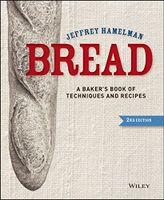Advertisement
Forming a Strand for Braiding
Appears in
Published 2004
Beautifully formed braids begin with beautifully formed strands. There are examples of braiding techniques in this book that utilize just 1 strand of dough up to as many as 70 strands. Regardless of the number, the technique used to form them is the same.
Most doughs used for braiding are comparatively stiff, and the pieces should remain covered with plastic at all times. Also, due to their stiffness, any excess of flour on the work surface will impede shaping, as the dough will tend to slide and not roll. Once scaled, the small dough pieces should be preshaped in either a round or oval form. When sufficiently relaxed, take a piece from under the plastic and place it on the work surface in front of you, seam side down. It is unlikely that flour will be necessary on the work surface, but lightly floured hands will help during the shaping process. Begin by placing the flat part of one hand on top of the dough. Press firmly into the dough while rolling it back and forth 3 or 4 times. The goal is to form a sort of dog-bone shape, with a narrow center and bulbous ends. Once this is accomplished, place both hands onto the dough, with the index fingers of each hand touching. Roll the dough back and forth with good downward pressure from your hands, and at the same time extend your hands outward in order to elongate the strand. The stroke is finished when each hand has worked all the way out to the end portion of the dough. If the strand is not long enough, return your hands to the center of the dough and repeat the motion. Depending on how relaxed the dough is when the shaping began, and the final length needed for the strand, you may have to return to the center and repeat the rolling motion 3 or 4 times. Often, the strand is almost at its finished length, but it is not symmetrical. When this occurs, do not continue to bring both hands to the center and roll outward in an equal fashion—this simply exacerbates the irregularity of the shape. Instead, bring one or both hands to the area that needs tapering, and work only on that area of the dough. The strand is finished when it is both long enough and has an even, gradual, symmetrical taper.

